Fertility Recommendations for
Specialty Crops
Suggested approaches to fertilizing specialty crops with no established Ontario recommendations
Fertility recommendations in Ontario are approved by the Ontario Soil Management Research and Services Committee (OSMRSC) and are primarily based on Ontario-specific research. The majority of the specialty crops listed in this program do not have approved fertility recommendations because of no or minimal research under Ontario growing conditions. For these crops it can be difficult to determine how much fertilizer or manure to apply to provide adequate nitrogen, phosphorus or potassium. Under application of nutrients can reduce yield and quality, while over application can have similar effects, can be costly, and can lead to environmental damage.
A good starting point for any of the specialty crops listed in this program is to consider the following points/ steps:
- Take a soil test. For more information see the section soil testing.
- Ensure soil pH is adequate for the crop. For more information see the section pH.
- Look at the current approved OSMRSC fertility recommendations for closely related crops, which are available in OMAF and MRA publications (For more information click resources) and consider the following:
- Plant family - crops in the same plant family often have similar nutrient requirements. For example, there is no recommendation for tomatillos in Ontario, but the recommendation for fresh market tomatoes would be a good starting point.
- Harvested portion - nutrient requirements differ depending on the portion of the plant harvested (e.g. leaf, stem, root, tuber) . For example, dill is closely related to carrots, but it unlikely they would have similar nutrient requirements because carrots are a root crop while dill is a leafy green
- Days to maturity - longer-season crops will generally require more nutrients than a closely related short-season crop. Similarly, crops producing a large amount of biomass will likely have higher nutrient requirements than those producing low amounts of biomass. For example, while the Asian Brassica greens such as Shanghai pak choy are closely related to storage cabbage, they are unlikely to require the same amount of fertilizer because storage cabbage can take 150 days to mature and produce large amounts of biomass , while some of the Asian greens only require 30-60 days to mature and have much lower biomass. Note: Fruit and vegetable crops typically have very high yields compared to grain crops, but often have lower biomass because of their high moisture content.
The requirement of a crop for supplemental nutrient application is also dependent on a wide range of factors including rainfall/irrigation, temperatures, soil type, soil organic matter, pH, and cultivar/variety. Consequently, research conducted outside of Ontario will not necessarily apply to Ontario growing conditions because of differences in climate and soil factors. In this program, in cases where there are no Ontario fertilizer recommendations or Ontario specific research, research and recommendations from the regions with the closest climate and soil conditions to those of Ontario are provided in the individual crop profiles. These are only provided as a starting point, and should be used to develop on-farm trials to test a range of nutrient application rates and determine optimal rates for local growing conditions.
Specialty crop growers should conduct their own research to determine the ideal fertilizer or manure requirements of the crop for their own growing conditions. Click here for information on how to conduct on-farm research trials.
Nitrogen (N)
Nitrogen recommendations are not generally based on a soil test. Research and recommendations are often based on the response of the crop to supplemental N application. In this program, the total amount of N required to optimize marketable yield and/or quality under specific conditions are listed in the individual crop profiles. Keep in mind, that these requirements only apply to the specific growing conditions listed, and may not apply to all Ontario growing conditions. It is also important to note that optimal yield does not always correspond with optimal quality. For example, the concentration of medicinally active components in many medicinal herbs often decreases with increasing yield. The optimal rate of N for these crops will depend on the market and whether the price is based on weight or the concentration of medicinal components.
When deciding on a rate of N to apply to the crop, a grower should also consider the amount of N applied through the incorporation of organic matter such as compost, manure, legume cover crops and crop debris.
Adjusting nitrogen rates for Ontario growing conditions:
- Reduce applied nitrogen fertilizer rates if manure is applied prior to planting (Table 1). The table shows the average values typically found in different types of manure. Because of the variability in manure quality, growers should have their own manure analysed each year and adjust N application rates accordingly.
- Reduce applied N fertilizer rates if legumes or legume cover crops are incorporated prior to planting (Table 2)
- Adjust applied N fertilizer rates with soil texture. Heavy clay soils have much slower water infiltration rates and lower losses of N due to leaching. However, they are more prone to denitrification losses when the soil is saturated. On the other hand, loss of N due to leaching is high on sandy soils during heavy rainfall events. While minimal research has been conducted on specialty crops, split application of N may be beneficial on sandy soils to reduce the losses due to leaching.
While N application rates should be adjusted based on the addition of organic matter from external sources, the organic matter content of the soil does not necessarily provide an indication of the need for supplemental N application. Nutrients can be tightly bound to organic matter in the soil resulting in lower nutrient availability to the plant. High organic matter in the soil can reduce leaching losses throughout the season. As a result, N recommendations for soils high in organic matter (e.g. muck soils) are often different from those on mineral soils low in organic matter.
In some cases, the N requirements of a crop are unknown. For these crops, it is best to begin with the N recommendations of similar crops in Ontario and conduct small, on-farm trials with rates of N above and below those recommendations.
Phosphorus (P) and Potassium (K)
Adjusting phosphorus & potassium rates for Ontario growing conditions:
- Reduce/adjust applied P & K fertilizer rates if manure applied prior to planting (Table 1)
Phosphorus and K are less mobile in the soil than N and adsorb to soil and organic matter particles. Consequently, soil concentrations of these nutrients are more stable and provide a better indication of the amount available to the plant. Supplemental application of these nutrients should always be based on a soil test conducted in the fall or spring before planting. The exact P and K requirements for most specialty crops are unknown. However, the recommendations for similar crops in Ontario can provide a good starting point. Growers will have to monitor soil levels of P and K over time and adjust fertilizer applications if soil concentrations decrease or increase in subsequent years.
General:
- Regardless of soil texture/type, if soil test phosphorus P (sodium bicarbonate) is greater than 60 ppm no additional phosphorus is required
- Regardless of soil texture/type if soil test potassium (K) (ammonium acetate) is greater than 180 ppm no additional potassium is required
- P & K applied at the beginning of season prior to planting will be adequate for the full season even if the field is multi-cropped within one season (e.g. 1 application for 4 consecutive plantings of Shanghai pak choy)
Table 3 provides a list of the specialty crops included in this module along with the most similar traditional crop based on plant family, harvested portion, and days to maturity. The Ontario recommendations for traditional crops are provided in Tables 4, 5, 6 etc. Keep in mind that the recommendations for related traditional crops may not be appropriate for specialty crops, and growers should constantly monitor any specialty crop for nutrient deficiency or toxicity symptoms. For more information on specific nutrients see the nutrients and micronutrients sections.
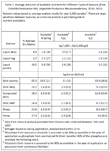 Click to Enlarge |
Table 1 |
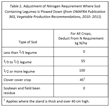 Click to Enlarge |
Table 2 |
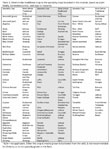 Click to Enlarge |
Table 3 |
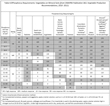 Click to Enlarge |
Table 4 |
 Click to Enlarge |
Table 5 |
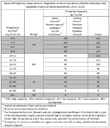 Click to Enlarge |
Table 6 |
 Click to Enlarge |
Table 7 |
 Click to Enlarge |
Table 8 |
 Click to Enlarge |
Table 9 |
 Click to Enlarge |
Table 10 |
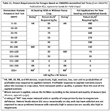 Click to Enlarge |
Table 11 |
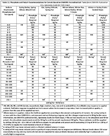 Click to Enlarge |
Table 12 |







